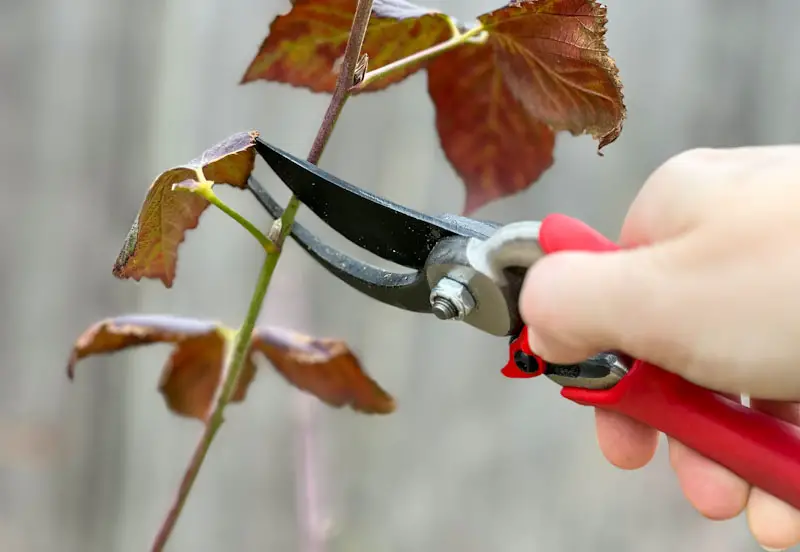
We may receive commissions from purchases made through links in this post, at no additional cost to you.
Blackberries are one of the simplest things to grow in the home garden. They typically don’t take much maintenance or extra care, and they’re adaptable to different soils and climates. But, if you do one thing to care for your blackberry bushes, let it be pruning.
Regular pruning is the solution to so many blackberry problems. Do you want sweeter berries? Prune. Larger berries? Prune. Do you have disease issues? Production problems? Overgrown, unwieldy shrubs? Prune!
Pruning can be an intimidating garden chore…but take comfort in the fact that there is more than one right way to do it. Even experts will disagree on the details, and every grower has their preferred methods to get the job done. But the important thing is to do it at all – you’ll see big results if you do.
This article will explore everything you need to know to do your own blackberry pruning. We’ll talk about why pruning blackberries is so important and what times of year to do it. You’ll find detailed pruning instructions for different types of blackberries, step-by-step photos, and a quick at-a-glance reference guide that you can take out to the garden with you. By the end, you’ll feel confident enough to tackle this task yourself.
Why do blackberries need pruning?
Blackberries need to be pruned to control the plant’s overall size, increase the berry harvest, and improve fruit size and sweetness. Pruning will also increase air circulation around the plant, minimizing pest and disease issues.
In the video below, I show you exactly how I prune my summer-bearing ‘Arapaho‘ and ‘Navaho‘ blackberry bushes in the spring. Watch as I apply the steps above…you can clearly see the difference in the before and after!
To understand why pruning is so important, we first need to look at how blackberry bushes grow. In fact, blackberries aren’t exactly bushes at all. They are considered brambles – a term that encompasses any prickly, tangled shrub, particularly those in the Rubus genus (such as blackberries and raspberries).
Blackberries fall into several different growing-habit categories, such as erect (or upright), semi-erect, or trailing. Trailing blackberry plants resemble vines and need the support of a trellis or other climbing structure.
Erect and semi-erect blackberries are more shrub-like, with sturdy canes that can arch toward the ground as they grow longer. Semi-erect berries are exactly what they sound like – not as upright as the erect varieties, so they may also need additional support.
There are two ways a blackberry plant can produce fruit. Summer-bearing varieties flower and fruit on 2-year-old canes, also called floricanes (flora=flower or blossom). Fall-bearing blackberries (also called primocane, or everbearing blackberries) can also fruit on 1-year-old canes (primocanes).
As you can imagine, each type of blackberry plant has somewhat different pruning requirements, depending on its growing and fruiting habits. But no matter what type you are growing, pruning will greatly affect the quality of the fruit you get.
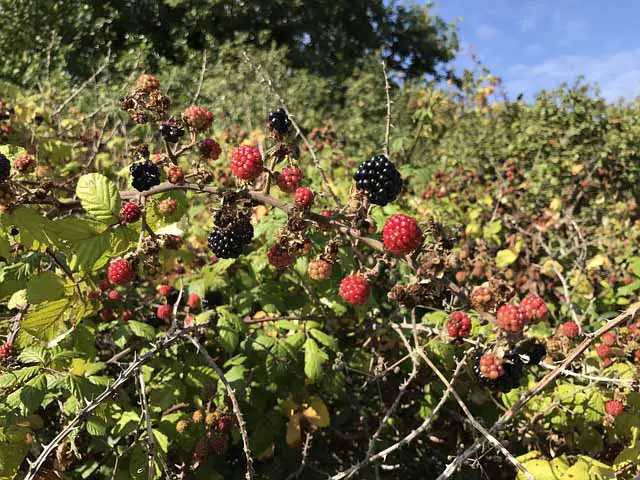
At its simplest, pruning reduces the amount of growth that the plant has to support, leaving more energy and resources to put toward producing fruit. Limiting the size of the canes and branches, as well as the overall shrub, will cause the berries to grow larger.
Learn more: 6 Ways to Grow Bigger, Juicier Blackberries
Thinning the growth will also allow more light to reach each berry, increasing the sugar content of the fruit. Have you ever wondered why your berries are so tart? It could be because the fruit isn’t getting enough sun to ripen to full sweetness.
Learn more: Why are my Blackberries Sour? Tips to Grow Sweeter Berries
Pruning the growth back will also improve air circulation around and through the shrub. The better the air circulation, the lower the risk of diseases or pest infestations taking hold of the plant.
When to Prune Blackberries
Pruning can accomplish different purposes, depending on what time of year it’s done. Pruning essentially sends messages to the plant to release certain hormones that make it grow in a particular way. Trimming the plant while it is dormant, for example, will affect growth differently than trimming during the growing season.
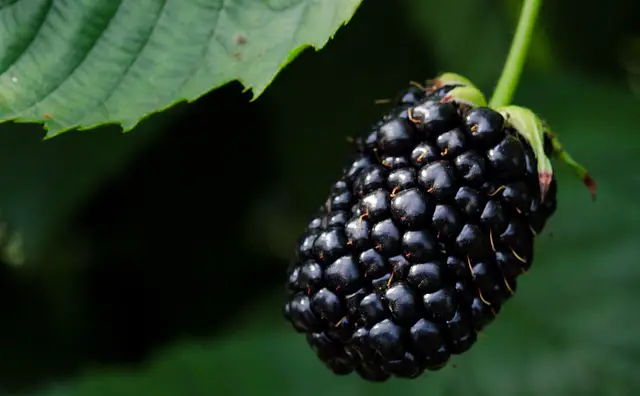
In the late winter or early spring, prune blackberry plants to remove dead growth, thin weak canes, and limit the size of the remaining canes and branches. This will help the plant have plenty of energy for producing blossoms and berries, and increase the potential size and quality of the fruit.
In the summer, as the plant is growing new primocanes that will fruit the following season, prune to limit the size of the new primocanes. Tip-pruning these canes will encourage branching below the cut, increasing the available plant surface area that can produce fruit next year.
In the fall, after all of the berries have been picked, prune to remove the spent fruiting canes. The floricanes that produced berries this year will die once they are done fruiting. Removing these dying canes will conserve the plant’s energy as it prepares for dormancy, and will reduce the risk of overwintering pests or disease pathogens.
Learn more: The Best Times to Prune Blackberries (for a HUGE Harvest!)
How to Prune Summer-Bearing Blackberries
Gather Your Tools
The equipment required for pruning blackberries is simple. Pruners, loppers, and gloves are all you need. I use a pair of bypass pruners like this one, which provides a clean cut without compressing or tearing the plant.
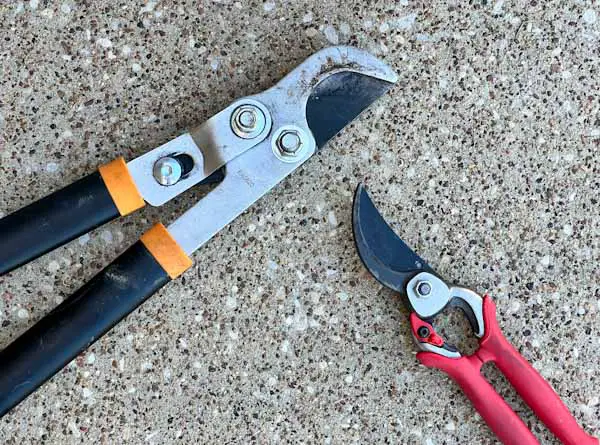
For thicker branches or canes, you may need to use some bypass loppers, such as these (which I use). The longer handles allow you to cut thicker growth, using more force with less effort.
Gloves aren’t as essential with thornless brambles as they are with thorny ones. But in either case, it’s a good idea to protect your hands from nicks and scratches when pruning. I prefer a leather pair of gloves such as these (this is a 2-pack!). Don’t forget to wear long sleeves if you’re tackling blackberry bushes with thorns.
The most important step is to thoroughly clean and disinfect your pruners before making any cuts. Fungal spores, bacteria, or other harmful substances can transfer from one plant to the next by way of dirty gardening tools. After cleaning with soap and water, wipe the entire surface of the tool with isopropyl alcohol to disinfect.
Dormant Pruning (Late Winter/Early Spring)
Most blackberry pruning should be done while the plant is dormant. Depending on the climate, the plant may or may not lose all of its leaves over the winter, but it will stop growing. The best time to prune is right as you start to see the buds swell, or just before, in the late winter or very early spring.
Step 1
Begin by completely removing any dead or diseased canes or branches. This could include spent floricanes that were not removed after fruiting the previous year. Cut all dead or diseased growth down to the crown, at soil level.
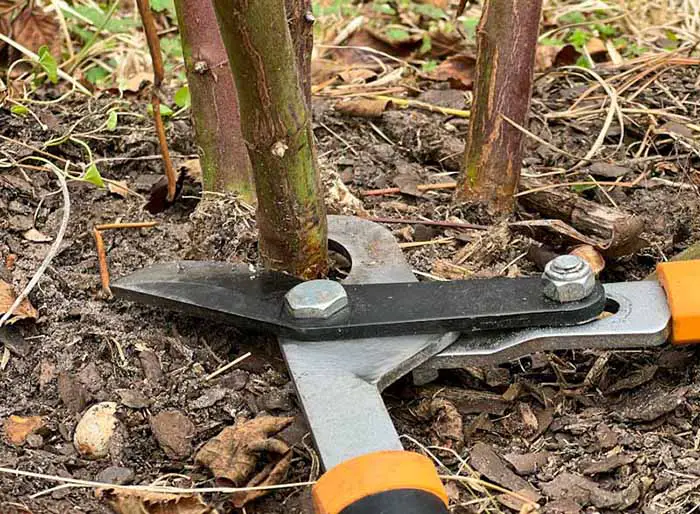
Step 2
Next, choose the strongest 4 to 6 canes to keep, and remove the rest. Look for canes that seem thin, weak or spindly. Thin out canes that may be growing too close together. You want the strongest, sturdiest canes to grow and fruit this year.
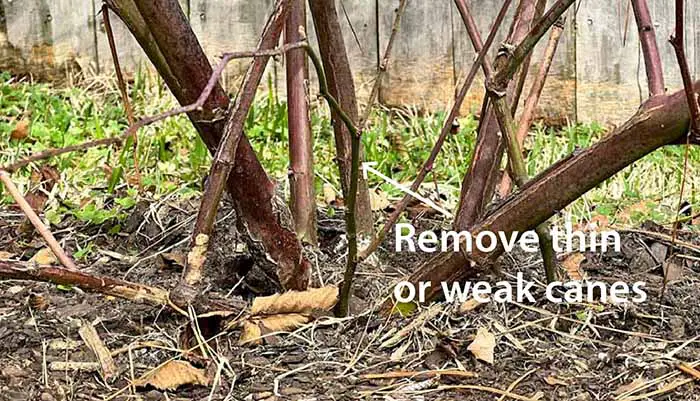
Step 3
If the remaining canes are very long, trim off the tips so that the canes are 36-48 inches long (3 to 4 feet). Limiting the length of the canes will allow more branching and blossoming, leading to better fruit set.
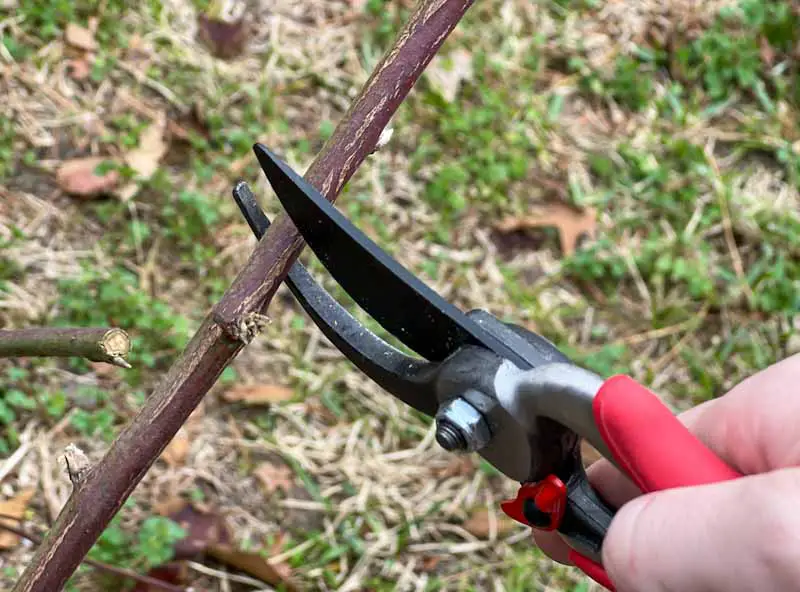
Step 4
Trim any lateral branches off of the main canes to be 12-18 inches long. It may seem counterintuitive, but shortening the branches will actually cause the plant to produce more blossoms and better-quality fruit, since it won’t have to support as much growth.
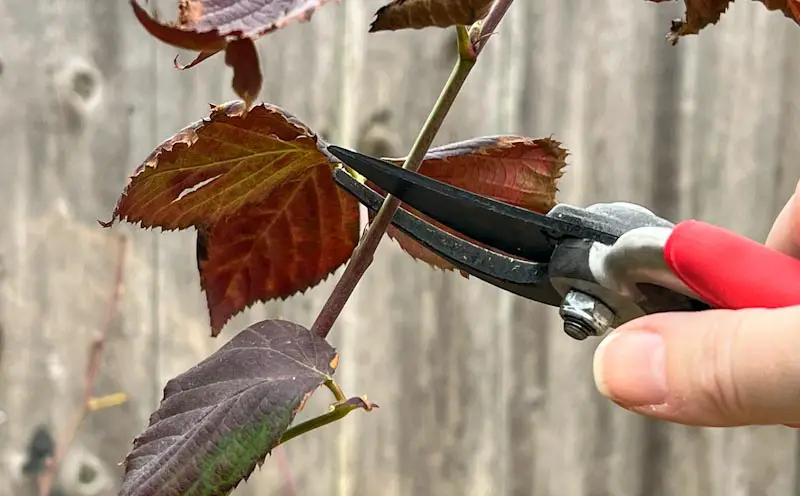
If you are growing an erect blackberry variety, then you’re done pruning for the dormant season – skip the next section. If you are growing a semi-erect or trailing variety, then go on to Step 5.
Step 5
Re-attach canes and branches to your trellis or support system. Semi-erect blackberries may not need as much support, but they can benefit from some staking to support the plant as fruit develops. Trailing varieties need to be tied to a trellis or fence to keep them from growing along the ground.
Pruning During the Growing Season (Summer)
Once the warm weather hits, the blackberry plants will start growing. The 2nd-year floricanes will produce leaves, branches, and blossoms. New primocanes will grow from the base of the plant at the crown.
Step 1
Once the canes grow to 36-48 inches tall (3-4 feet), trim a few inches off the top. Canes will grow at different rates, so you may have to do this a few dimes during the season.
If your bush is attached to a trellis, then let the canes grow 4-6 inches past the trellis wire, then tip-prune them so they reach 1-2 inches above the wire. This will encourage the cane to branch at the height of the trellis wire.
Pruning After Harvest (Late Summer/Fall)
After the plant has produced its berries, the floricanes will die. It’s easy to tell which are the spent floricanes because you will see the empty berry calyxes branching off. The cane will also start to brown and get brittle as it dies.
Step 1
Trim the spent floricanes down to the soil level. Shorten the remaining primocanes that, if needed (to 36-48 inches).
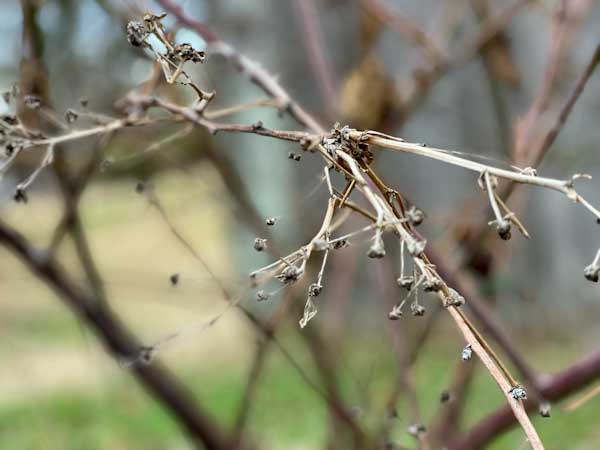
Step 2
If it’s a trailing blackberry variety, you may need to protect the plant over the winter (trailing blackberries tend to be less hardy than erect varieties). Before the first frost, detach the canes from the trellis and lay them on the ground. Trim the lengths, if necessary.
Cover the trailing canes with a 4- to 6-inch layer of mulch, leaves, or pine needles, or with a frost blanket or other insulating cover. You can even mound up snow over the canes to insulate them from the colder air. Remove the mulch or cover as the ground begins warming up in spring.
Learn more: The Best Blackberry Varieties for Cold Climates
How to Prune Fall-Bearing (Primocane) Blackberries
There are two ways to prune fall-bearing blackberries. The 1-crop method is the simplest, essentially removing all second-year canes and leaving only the primocanes each year. But, this will result in the plant only bearing fruit once during the season in the early fall.
The 2-crop method allows fruit to grow on both second-year canes in summer and first-year canes in fall. The crops may be smaller, but you’ll have blackberries ripening over a longer period.
Note that if you are in a very cold climate with early frosts, the fall-bearing blackberries may not have time to ripen before winter weather hits. It may be better to grow summer-bearing blackberries to get a larger crop earlier in the season.
1-Crop Method (Fall-Bearing)
Step 1
After harvest, in the late winter, cut or mow all of the canes to the ground. In the spring, new primocanes will grow from the crown of the plant.
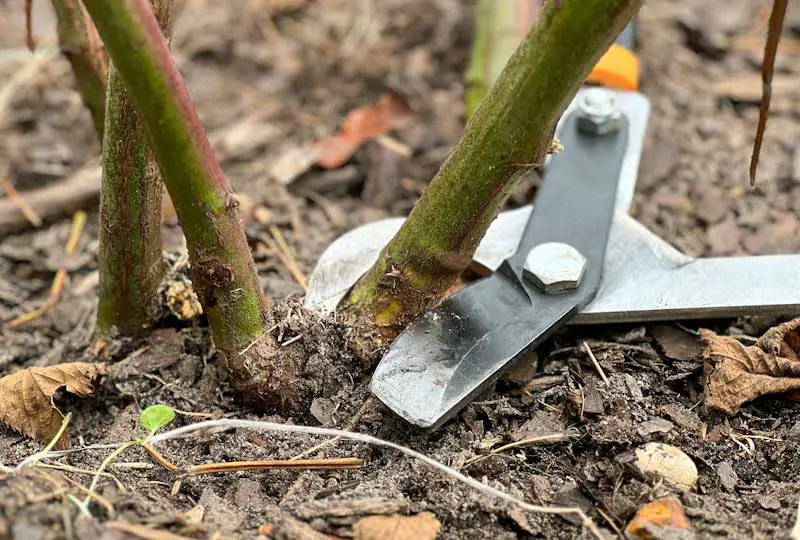
Step 2
To improve the harvest, tip-prune the primocanes during the growing season once they reach at least 3 feet long. Let the canes grow longer, then cut off the top several inches. This will encourage lateral branching and more surface area for berries to grow.
However, tip-pruning will delay the fall harvest somewhat. If you want an earlier harvest, or if you notice flowers or buds already forming on the tip of the cane, don’t tip-prune.
If you want your fall berry crop even sooner, you can speed up budding in the early spring by covering the plants with clear plastic or other light-penetrable fabric to create a warmer microclimate. Remove the covering once you notice blossoms starting to open.
The 1-crop method is best if you are concerned about your blackberry plant’s winter hardiness. The crown of the plant will survive in the ground over winter, and you don’t have to worry about exposed canes dying back because of cold damage. As long as you have a late enough frost date in fall for the berries to fully ripen, this is the simplest way to ensure winter survival.
2-Crop Method (Everbearing)
Step 1
In late winter while the plant is dormant, remove only dead or diseased canes. These will be the second-year floricanes that produced fruit the previous summer. They’re easy to spot because they will be dry, brittle, brown, and dead-looking.
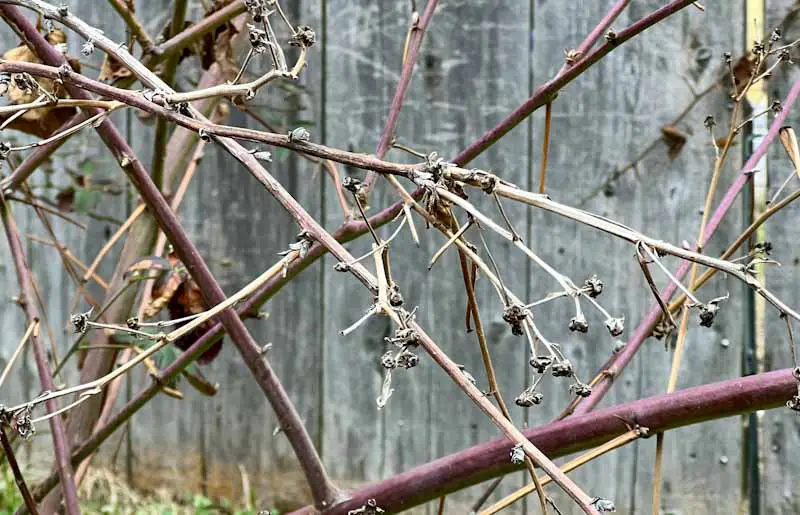
The canes that fruited the previous fall will now blossom and fruit in summer on second-year growth. New primocanes will grow from the crown of the plant in spring, then fruit in the coming fall.
Step 2
If desired, you can tip-prune the primocanes at 3 feet to delay and improve the fall harvest, as mentioned above.
Is there a difference in pruning thorny vs. thornless blackberries?
When pruning thorny blackberry plants, it is essential to protect hands and arms with leather gloves and long sleeves. Thorny plants sometimes produce more vegetation and canes than thornless ones, so it may be necessary to do more thinning of the plant.
Blackberry Pruning Before and After
Below is one of my ‘Navaho’ blackberries before dormant pruning:
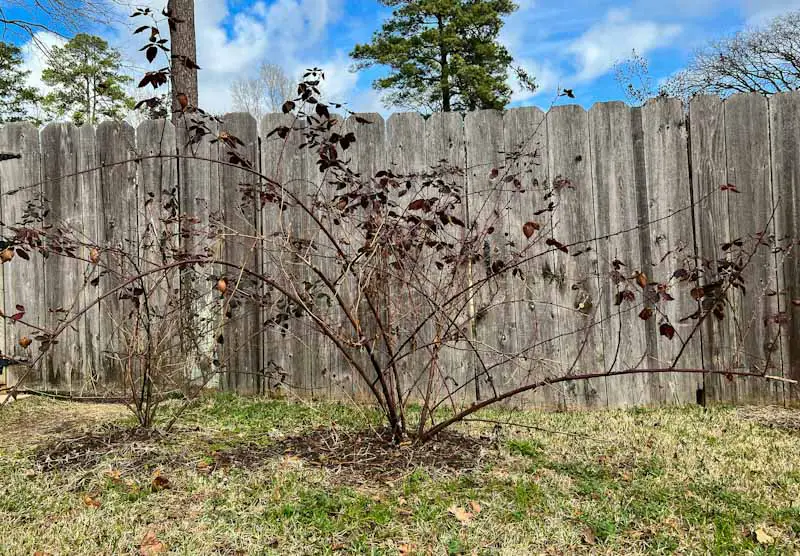
And here is the same plant after pruning, following the steps above:
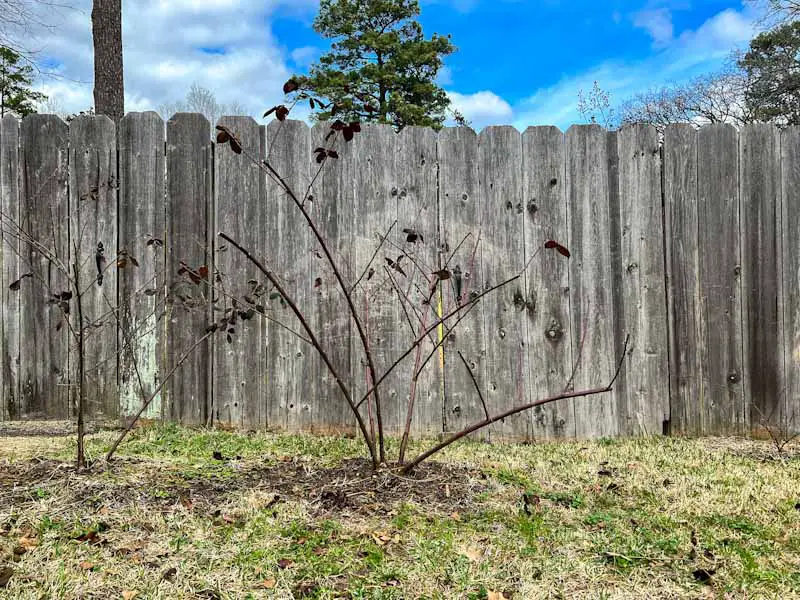
The canes have been thinned at the base and tip-pruned to about 42 inches, and lateral branches have been shortened.
At-A-Glance: Blackberry Pruning Quick Reference Guide
Summer-Bearing Blackberries
- IN LATE WINTER: Remove dead or diseased canes or branches.
- Keep the strongest 4 to 6 canes, trim the rest to the ground.
- Tip prune canes to be 36 to 48 inches long.
- Trim lateral branches to be 12 to 18 inches.
- For trailing blackberries, re-attach to trellis as needed.
- IN SUMMER: As canes grow, tip prune to be 36 to 48 inches long (or the height of the trellis wire)
- IN FALL: After fruiting, trim spent floricanes to the ground. Shorten remaining primocanes as needed.
- Cover trailing blackberries to protect for the winter, if necessary.
Fall-Bearing Blackberries
- FOR A FALL CROP: Trim or mow down all canes in the late fall after fruiting. For a larger harvest, tip prune during the growing season once the canes grow beyond 3 feet.
- FOR A SUMMER AND FALL CROP: Remove dead or diseased canes at any time (including 2-year-old floricanes that have already fruited. Keep primocanes over winter, trimming length as necessary, so they will fruit the following summer.

